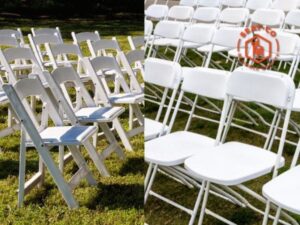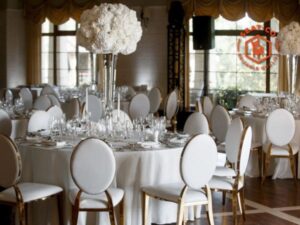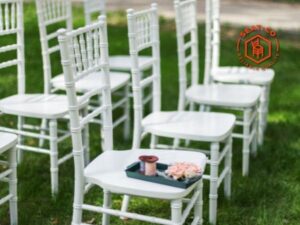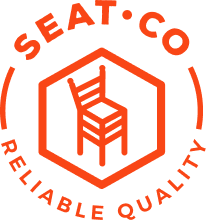Balancing Maintenance Costs with the Value of New Investments
Written by: Marcelo Flores
In the world of events, the appearance and quality of your seating can significantly impact your business reputation. However, chairs, much like any frequently used equipment, have a lifecycle. Understanding when to replace the chairs, rather than persisting with repairs and maintenance can save costs and elevate your guests’ experience. This guide will help you navigate the decision-making process, ensuring your venue always leaves a lasting, positive impression.
Table of Contents
1. Assessing Chair Condition: The First Step
2. Signs It’s Time to Replace Your Chairs
3. Calculating Maintenance and Repair Expenses
4. Evaluating Your Seating: A Checklist
5. The ROI of Investing in New Chairs
6. Future-Proofing Your Investment: The Residual Value
7. Making the Switch: Steps to Update Your Inventory
1. Assessing Chair Condition: The First Step

In the event rental world, both the look and condition of your chairs are crucial. They need to be more than just functional; they must also enhance the event’s aesthetics. But there’s a practical side to this too—keeping your chairs in top shape can become costly. Here’s why and how to assess if it’s time for an upgrade:
Visual Appeal and Theme Compatibility
Chairs that match and elevate the event theme are more likely to be rented. If your chairs start to look outdated or worn, they could detract from the event’s overall look, potentially harming your reputation and bottom line.
Maintenance and Upkeep Expenses
Every chair has a lifespan. Over time, the cost of repairs and maintenance can exceed the chair’s value or the cost of replacement. Regularly assess these expenses; if keeping your chairs in good condition is becoming increasingly expensive, it might be time to consider new options.
Cost vs. Benefit of Upkeep
Calculate how much you’re spending on maintaining your chairs versus their rental income. There’s a tipping point where it’s more economical to invest in new chairs rather than pouring more money into old ones.
The Impact on Your Business Image
First impressions matter. Chairs that are visibly worn or out of style can negatively impact your clients’ perception of your business. High-quality, good-looking chairs reflect well on your services and can justify higher rental rates.
Making the Decision
When the costs of maintenance rise and the aesthetic appeal of your chairs declines, it’s a clear indicator that it’s time to refresh your inventory. This doesn’t just protect your business image; it can also open up new opportunities for growth and increased profitability.
2. Signs It’s Time to Replace Your Chairs

Knowing when to replace your chairs is crucial for maintaining the quality and reputation of your rental business. Here are key signs that it’s time for an update:
- Visible Wear and Tear: The most obvious sign is visible damage. Scratches, dents, or stains that can’t be removed not only make chairs less appealing but also reflect poorly on your business.
- Frequent Repairs: If you’re constantly fixing the same chairs, the cost and effort may outweigh the benefits. Frequent repairs indicate that the chairs are past their prime and are likely to cause more issues in the future.
- Outdated Style: Trends in event planning change over time. Chairs that once were in high demand may now look outdated. Keeping up with trends is essential to attract clients.
- Safety Concerns: Any signs of structural weakness — like wobbly legs or cracked frames — pose safety risks. For liability reasons and to ensure client trust, it’s vital to replace chairs that could potentially cause accidents.
- Negative Feedback: Listen to your clients. If you receive comments about the chairs being uncomfortable or looking worn-out, it’s a clear signal that replacement is necessary.
- Decreased Rentals: If certain chairs are consistently being passed over by clients for newer or better-maintained options, it’s a sign that they no longer meet market expectations.
- Comparing Costs: Evaluate the cost of ongoing maintenance versus purchasing new chairs. If the long-term costs of repairs and upkeep surpass the investment in new chairs, it’s financially smarter to update your inventory.
3. Calculating Maintenance and Repair Expenses

Understanding the true cost of maintaining your inventory is critical to making informed decisions about when to replace your chairs. Here’s a step-by-step guide to help you calculate your maintenance and repair expenses:
- Track Expenses Over Time: Start by gathering all expenses related to the maintenance and repair of your chairs over a specific period, typically a year. This includes costs for replacement parts, labor for repairs, and any special cleaning or refurbishment services.
- Average Cost Per Chair: Divide the total maintenance and repair expenses by the number of chairs in your inventory to find the average cost per chair. This figure gives you a clear idea of how much each chair costs you in upkeep annually.
- Consider the Impact of Downtime: Every time a chair is out of circulation for repairs, it’s not generating revenue. Estimate the loss in rental income for chairs undergoing maintenance and add this to your total expenses.
- Compare Costs with Replacement: With your average maintenance cost per chair in hand, compare this amount to the cost of purchasing new chairs. If the annual cost to maintain a chair approaches or exceeds the price of a replacement, it’s financially prudent to invest in new inventory.
- Factor in Depreciation: Chairs depreciate over time, both in terms of their market value and their appeal to clients. Consider how depreciation affects the overall value of your inventory and its return on investment.
- Evaluate Intangible Costs: Beyond direct expenses, consider the impact of outdated or poorly maintained chairs on your brand reputation and client satisfaction. Negative feedback or lost business can be more costly in the long run.
4. Evaluating Your Seating: A Checklist

To decide whether it’s time to replace your chairs, it helps to have a clear checklist to evaluate their condition. Use this checklist to assess each chair in your inventory:
- Visual Appeal: Do the chairs still look attractive? Check for fading, stains, or discoloration that might detract from their appearance.
- Structural Integrity: Are the chairs sturdy? Test for any wobbling, broken parts, or signs of weakening in the frame.
- Comfort: Sit in the chairs to assess their comfort level. Chairs that have become uncomfortable can negatively impact guest experiences.
- Functionality: Ensure all moving parts (if any) work correctly. Chairs that are difficult to set up or fold (if applicable) may need replacing.
- Wear and Tear: Look for excessive signs of wear, like torn fabric, cracked wood, or bent metal. Minor issues can be repaired, but extensive damage might warrant replacement.
- Compliance with Current Trends: Are the chairs still in style, or have they fallen out of favor with current event trends? Outdated designs can be less appealing to renters.
- Safety: Check for any safety hazards, such as sharp edges, splinters, or broken mechanisms that could harm users.
- Repair Frequency: How often do these chairs require repairs? Frequent fixes can be a sign that it’s time for an update.
- Customer Feedback: Have clients commented on the chairs? Negative feedback can indicate it’s time for new seating.
Download a copy of this checklist here
5. The ROI of Investing in New Chairs

Calculating Rental Rate Increases
Evaluating the potential for rental rate increases with new chairs is crucial. Quality, style, and comfort can justify higher prices. Consider how much more you could charge for events with updated seating. This increase directly impacts your ROI, making the investment in new chairs more appealing.
Reducing Maintenance and Repair Costs
Factor in the savings from reduced maintenance and repair costs. Durable, modern chairs mean fewer fixes and replacements. Calculate your current yearly expenses on chair upkeep and compare them to the projected costs with new chairs. Savings here can significantly contribute to a positive ROI.
Enhancing Brand and Customer Satisfaction
New chairs can elevate your brand’s market position. They can make your service more attractive, leading to increased bookings and repeat customers. Happy customers are likely to refer your business, expanding your client base without additional marketing costs.
Longevity and Operational Efficiency
Assess the longevity and operational efficiency of new chairs versus old ones. Chairs that last longer and require less maintenance offer better long-term value. Also, consider if new chairs are lighter or easier to set up, which could reduce labor costs and streamline operations.
ROI Calculation
Combine these factors to calculate the ROI. Compare the total benefits (increased rental rates, savings on repairs, enhanced brand value) against the investment cost of new chairs. This calculation will help you determine the break-even point and the long-term financial impact on your business.
Leveraging Our ROI Calculator
To make this process easier, use our ROI calculator. It will help you assess the financial viability of updating your chair inventory, considering all the factors mentioned.
6. Future-Proofing Your Investment: The Residual Value

The Importance of Material Choice
Choosing chairs made from materials like aluminum and steel is a strategic decision that pays off in the long term. These materials not only ensure durability and maintain aesthetic appeal but also hold their value over time. Unlike chairs made from less durable materials, aluminum and steel chairs can be a valuable asset even as they age, offering potential financial returns through resale or recycling.
Durability and Aesthetic Appeal
The structural integrity and the maintained appearance of aluminum and steel chairs mean they are more likely to command a higher resale value. This durability ensures that the chairs can withstand frequent use without compromising on style or function, making them a wise choice for businesses looking to maintain a reputation for quality.
Residual Value and Financial Returns
Considering the residual value in your purchasing decisions can significantly reduce the total cost of ownership. When the time comes to replace your chairs, those made from valuable materials like aluminum and steel can still contribute financially to your business, either through resale or as recycled material. This approach not only aids in financial planning but also promotes sustainability within the event rental industry.
7. Making the Switch: Steps to Update Your Inventory

Explore Chair Options
Research various chair options, focusing on durability, style, and material. Consider chairs that align with your brand and meet the demands of your clientele. Samples or small purchases can be a prudent way to test chairs in real event settings before committing to a large investment.
Plan for Disposal or Resale
Decide what to do with your old chairs. If they’re made of valuable materials, consider selling or recycling them. This can provide additional funds to reinvest in your new inventory. Ensure that the disposal or resale process aligns with your company’s sustainability goals.
Monitor and Adjust
Keep a close eye on how the new chairs perform in terms of client satisfaction and maintenance needs. Be prepared to adjust your inventory based on these insights and the evolving preferences of your market.
In conclusion, updating your chair inventory is a strategic decision that impacts both your brand’s reputation and your bottom line. By carefully assessing the condition of your chairs, understanding the costs of maintenance versus investment in new ones, and considering the long-term benefits, you can make a decision that supports your business’s growth. Leveraging tools like our ROI calculator can guide you through this process, helping you choose the best path forward for your event rental business.
